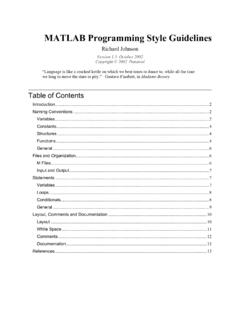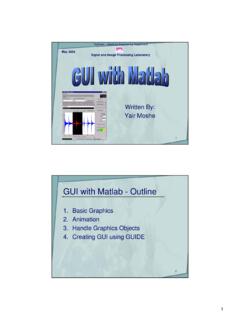Transcription of Fabrication Technology - Columbia University
1 Fabrication Technology By Department of Electronics and Communication Ghousia College of Engineering, Ramanagaram 1. OUTLINE. Introduction Why Silicon The purity of Silicon Czochralski growing process Fabrication processes Thermal Oxidation Etching techniques Diffusion 2. Expressions for diffusion of dopant, concentration Ion implantation Photomask generation Photolithography Epitaxial growth Metallization and interconnections, Ohmic contacts Planar PN junction diode Fabrication , Fabrication of resistors and capacitors in IC's. 3. INTRODUCTION. The microminiaturization of electronics circuits and systems and then concomitant application to computers and communications represent major innovations of the twentieth century.
2 These have led to the introduction of new applications that were not possible with discrete devices. Integrated circuits on a single silicon wafer followed by the increase of the size of the wafer to accommodate many more such circuits served to significantly reduce the costs while increasing the reliability of these circuits. 4. 5. WHY SILICON? Semiconductor devices are of two forms (i) Discrete Units (ii) Integrated Units Discrete Units can be diodes, transistors, etc. Integrated Circuits uses these discrete units to make one device. Integrated Circuits can be of two forms (i) Monolithic-where transistors, diodes, resistors are fabricated and interconnected on the same chip.
3 (ii) Hybrid- in these circuits, elements are discrete form and others are connected on the chip with discrete elements externally to those formed on the chip 6. 9 Two other semiconductors, germanium and gallium arsenide, present special problems while silicon has certain specific advantages not available with the others. 9 A major advantage of silicon, in addition to its abundant availability in the form of sand, is that it is possible to form a superior stable oxide, SiO2, which has superb insulating properties. 9 Gallium arsenide crystals have a high density of crystal defects, which limit the performance of devices made from it.
4 9 Compound semiconductors, such as GaAs (in contrast to elemental semiconductors such as Si and Ge) are much more difficult to grow in single crystal form. 9 Both Si and Ge do not suffer, in the processing steps, from possible decomposition that may occur in compound semiconductors such as GaAs. 9 Lastly, at the present time, silicon remains the major semiconductor in the industry. 7. THE PURITY OF SILICON. The starting form of silicon, which manufacturers of devices and integrated circuits use, is a circular slice known as a wafer. These wafer diameters vary from 10-20 cms with maximum up to 30 cms.
5 Silicon is found in abundance in nature as an oxide in sand and quartz . Silicon must be in 9 Crystalline form, 9 Very pure, 9 Free of defects, and 9 Uncontaminated. 8. Silicon From Sand ? 9. 10. The Czochralski Process To grow crystals, one starts with very pure semiconductor grade silicon, which is melted in a quartz -lined graphite crucible. The melt is held at a temperature of 1690K, which is slightly greater than the melting point (1685K) of silicon. A precisely controlled quantity of the dopant is added to the melt The ratio of the concentration of impurities in the solid, Co to that in the liquid, Ct, is known as the equilibrium segregation coefficient ko ko= Co/Cl Seed Crystal After having set up the melt, a seed crystal (a small highly perfect crystal), attached to a holder and possessing the desired crystal orientation, is dipped into the melt and a small portion is allowed to melt.
6 11. 12. 13. Here is a picture of a state-of-the-art 200 mm Si crystal as they are grown by the thousands for present day (2000) chip manufacture. 14. Ingot Slicing and Wafer Preparation In the final process, when the bulk of the melt has been grown, the crystal diameter is decreased until there is a point contact with the melt. The resulting ingot is cooled and removed to be made into wafers. The ingots have diameters as large as 200mm, with latest ones approaching 300mm. The ingot length is of the order of 100cm. 15. Slicing the wafers to be used in the Fabrication of integrated circuits is a procedure that requires precision equipment.
7 The object is to produce slices that are perfectly flat and as smooth as possible, with no damage to the crystal structure. The wafers need to be subjected to a number of steps known as lapping, polishing, and chemical etching. The wafers are cleaned, rinsed, and dried for use in the Fabrication of discrete devices and integrated circuits 16. Fabrication PROCESS. Oxidation The process of oxidation consists of growing a thin film of silicon dioxide on the surface of the silicon wafer. Diffusion This process consists of the introduction of a few tenths to several micrometers of impurities by the solid-state diffusion of dopants into selected regions of a wafer to form junctions.
8 Ion Implantation This is a process of introducing dopants into selected areas of the surface of the wafer by bombarding the surface with high-energy ions of the particular dopant. Photolithography In this process, the image on the reticle is transferred to the surface of the wafer. Epitaxy Epitaxy is the process of the controlled growth of a crystalline doped layer of silicon on a single crystal substrate. Metallization and interconnections After all semiconductor Fabrication steps of a device or of an integrated circuit are completed, it becomes necessary to provide metallic interconnections for the 17.
9 Integrated circuit and for external connections to both the device and to the IC. Silicon dioxide, as we shall see later, plays an important role in shielding of the surface so that dopant atoms, by diffusion or ion implantation, may be driven into other selected regions 18. 19. Etching Techniques Etching is the process of selective removal of regions of a semiconductor, metal, or silicon dioxide. There are two types of etchings: wet and dry In wet etching, the wafers are immersed in a chemical solution at a predetermined temperature. In this process, the material to be etched is removed equally in all directions so that some material is etched from regions where it is to be left.
10 This becomes a serious problem when dealing with small dimensions. In dry (or plasma) etching, the wafers are immersed in a gaseous plasma created by a radio-frequency electric field applied to a gas such as argon. Electrons are initially released by field emission from an electrode. These electrodes gain kinetic energy from the field, collide with, and transfer energy to the gas molecules, which results in generating ions and electrons. The newly generated electrons collide with other gas molecules and the avalanche process continues throughout the gas, forming a plasma. The wafer to be etched is placed on an electrode and is subjected to the bombardment of its surface by gas ions.













